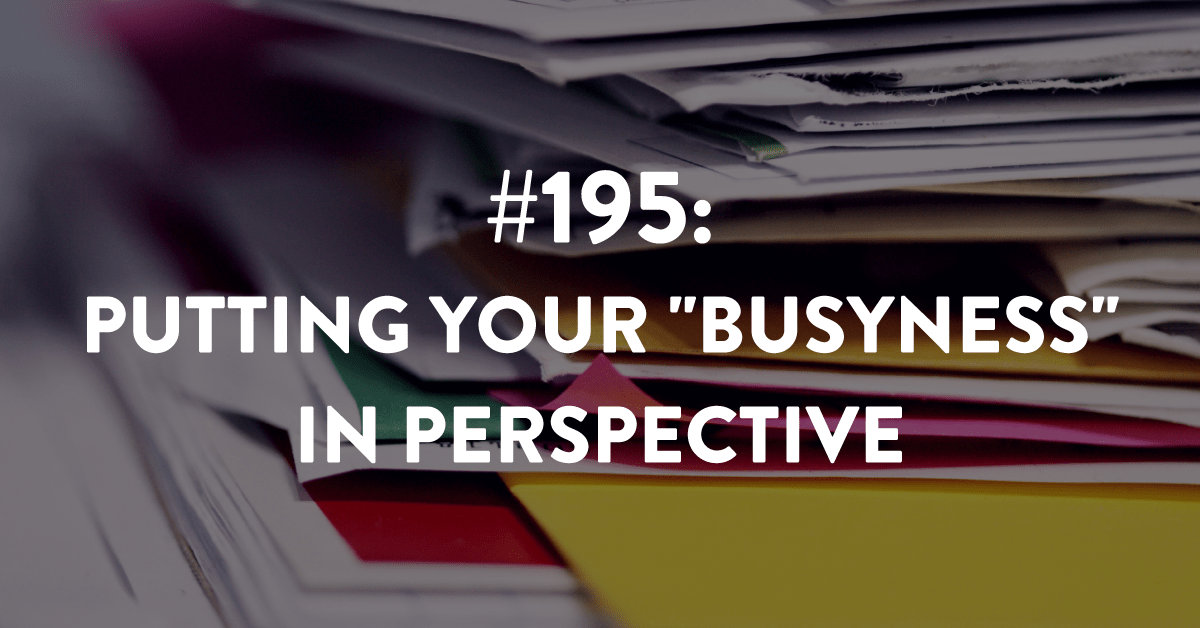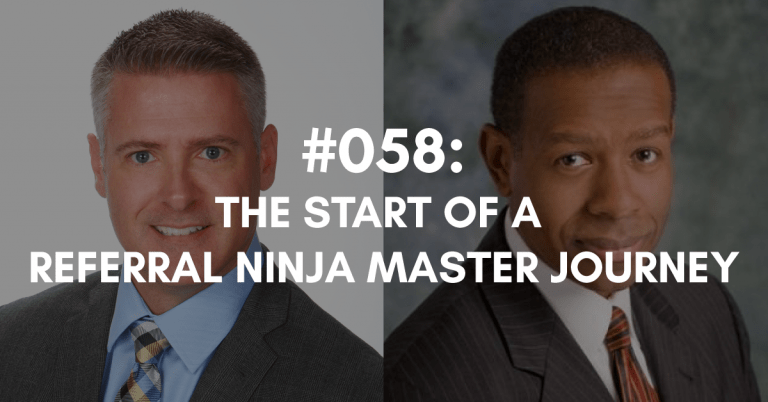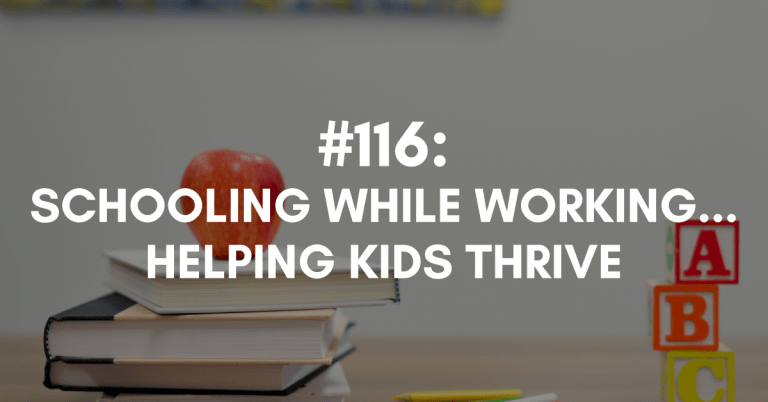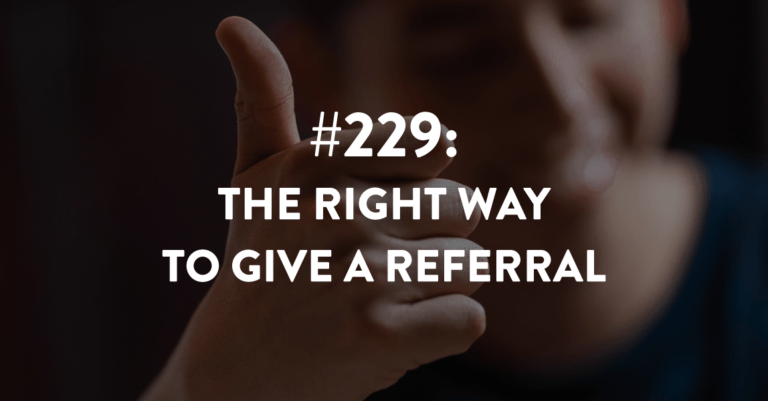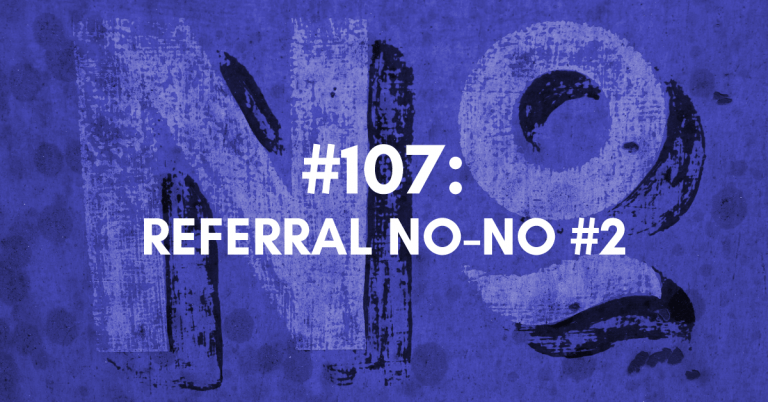Ep #195: Putting Your “Busyness” in Perspective
If there is one thing most of us can agree on, it’s that we’re busy. In this episode I want to put our “busyness” in perspective.
The word “busy” has a heaviness and social definition to it that we used to wear as a badge of honor. Now, however, we are a little more clued into the fact that being busy isn’t necessarily a sustainable or good thing. For many people, it is simply a matter of feeling out of control when it comes to how they are spending their time. So, today I will be sharing how I regain control of the “controllables” in my life.
First I will be explaining how to get back in alignment with the things that you should be spending your time on (that will ultimately move your business forward). You will learn how to categorize the things that must be done versus what can be done later, how to identify what is seasonal, and how to free yourself from a sense of overwhelm.
Share your thoughts on this episode or ask any questions you have in our Referrals Without Asking Facebook group!
Looking for Referral & Client Experience Resources:
Take the Referral Ninja Quiz to test your skills and abilities at generating referrals. (FREE)
Buy my book – Generating Business Referrals Without Asking – and learn how to generate referrals through my 5 steps. (LESS THAN $16)
Consider joining Building a Referable Business™ – a unique way to learn all of my referral strategies and tactics with ongoing weekly access to me to answer your questions and help hold you accountable! Email me for more details.
Coming Up:
Next episode is #196 where we will be discussing the speed of starting small.
Download The Full Episode Transcript
Read the Transcript Below:
Stacey Brown Randall: If there’s one thing we can all agree on, it’s that we’re busy. But with today’s episode, I want to help you put your busyness in perspective.
You are not just another hustling salesperson. You are the expert, the
resource, the valuable partner for your clients, and how you grow your
business should reflect how your clients see you.
Welcome to the Roadmap to Grow Your Business podcast. We generate
referrals without asking, build positive client experiences, and help
you take control of your business.
Here’s your charmingly sarcastic host, Stacey Brown Randall.
Stacey Brown Randall: Hey there, and welcome to episode 195 of the Roadmap To Grow Your Business podcast. I’m your host, Stacey Brown Randall. I can’t believe we’re almost at 200 episodes. This is a little crazy. I have been thinking for probably longer than I want to admit, what it looks like in terms of how I want to celebrate my 200th episode, and I think I finally landed on an idea that makes me really happy.
So stay tuned, there’ll be more details coming out and I will tell you that we’re going to make episode 200 all about you. All about you guys, all about the listeners. So just stay tuned, we’ll have more information coming up. And of course, it wouldn’t be the start of a new episode if I didn’t do a shout out to one of my clients.
This is Hannah. Hannah is an attorney. She is part of a three-partner firm, and in one year, following the strategies that we teach about referrals, she got 140 referrals. That’s right, woo hoo. Way to go, Hannah. 140 referrals, and that was in her second year of following the program.
One thing I do want to note is that when people come into the program, they start in many different places, and this is any of my programs, whether it is how to turn clients and contacts into referring machines when you’re trying to cultivate new referral sources, or growth by referrals, which is the process to how to take care of and get more referrals from your existing referral sources, or, of course, our BRB, which is Building a Referrable business.
We call it the whole enchilada because it includes those two I just mentioned and a whole lot more. It’s everything I teach. Or when they come into our client experience program, learning how to be more referable. We all come in, every client comes in and starts at a different place, which means that their results is going to be tied to what they have done in the past, and in most cases, what they have to overcome because of what they haven’t done the past.
And then some people come into the program with a pretty good understanding and a pretty good number in terms of referrals received, but what they’re really looking for is the system and the strategy, the process, the, I want to know what we are doing when it comes to generating referrals.
So, wherever you are right now, and you were thinking about a referral strategy, and you’re thinking about getting serious about that for your business, I just want you to know that please recognize where you start, whether it’s one of the strategies that I teach in one of my paid programs or, of course, it’s just the information you’re gleaning from this podcast, my book, and all the different videos, and other free content that we put out there in the world, like in our Referrals Without Asking Facebook group or that maybe you see posts for mine on LinkedIn.
What I want you to understand is that wherever you are is going to dictate not only where you start, but then how quickly or not so quickly you’ll see results. But you have to stick with it. And that’s what I love so much about Hannah’s results. They were in the program for a year and they did great. But then when they came back and they were like, “We’re going to do it even better our second year,” they had some amazing results, 140 referrals in one year, and they deserve every single one of them and I’m very, very proud.
And of course, as you guys know, you think about what that actually equates to in revenue, we’re talking thousands and lots and lots and lots of thousands of dollars. And I think that’s the point that some people miss when I talk about these numbers and I’m like, “Yeah, they get 50 referrals. They get 140 referrals. They get 78 referrals.”
And I think what people hear as I’m talking through that they I think, “That’s wow. That’s a lot of referrals. That’s awesome.” But what they’re missing out on is the dollar amounts that are actually tied to those referrals that they turned into clients. So, it’s awesome to hit the number, it’s even better when we realize the revenue that comes from it.
Okay, let’s dive into today’s episode. The title of today’s episode is Putting Your Busyness In Perspective. Let me start by asking you a question and then I’ll tell you where this episode is coming from. How are you doing? I realize I’m asking this into the audio abyss but you are hearing it. And I hope you take a minute to truly reflect on my question. How are you really doing?
Since the beginning of the year, I’ve spoken to so many that have had a different start to 2022 than they imagined, or than they expected or that they couldn’t even see coming. I think, for a lot of people, there has been this comparison over our last couple of COVID years, of course, but there was something about 2021 for many people, maybe not you, but for many people that after coming out of 2020 with the crazy chaos that it was, people started 2021 with an understanding of what the world looked like and this new normal, quote unquote of this COVID living actually looked like.
And they made a little bit of peace with it, understood it probably wasn’t going away anytime soon and they made the best of it. A lot of people had their best year ever last year. I know I did. But then 2022 started, and you’re almost comparing 2022 to 2021, except for the fact that there’s this heaviness, I think, for a lot of people, maybe not you and that’s awesome if you don’t have it.
But I think there’s this heaviness for a lot of people that feel like, “Wow, it’s just a little bit more of the same, but it doesn’t seem to be getting any better.” And now we’re not really quite sure where the light of the tunnel is or where the end actually is. And so I really wanted to ask this question, how are you doing? Because I caught myself the other day when somebody asked me that question, “How are you doing?”
I caught myself answering that question with a word that I actually don’t really like using? And somebody asked me, “How are you doing?” And I said, “I’m just busy.” And I actually don’t like that word, right? I mean, as a former productivity coach, there’s a big stinking difference between being busy and being productive. And I preach, when given the chance, on the differences between those two, I’m not going to do that to you right now. I’ll spare you my preach.
But I realized as the words tumbled out of my mouth that that’s actually how I was feeling. I was just feeling busy and I think busyness has a heaviness to it and a connotation to it and a social definition to it that we used to wear as a badge of honor, but now we’re a little bit more clued in to the fact that being busy, it’s like being a workaholic. It’s not something most people, some do, most people aspire to.
And so when I answered that question, busy, it hit me, “Oh, I know what this feeling means for me. I need to get a little bit more control over this feeling of busyness and what actually that means and control the controllables. I can’t control everything, so I won’t. But what I can control, I probably need to do a better job of controlling.”
And it was hearing myself say, “I’m just busy,” that was the moment the light bulb for me went off and it’s like, “Wait, I know what to do here. I know how to switch this feeling.” And I thought I would share some of those tips of what I do in that moment with you, because maybe you don’t need it right now, but maybe you’re going to need it in May or maybe you’ll need it in July or October or December. And if these tips can help you, I think that is great.
Now, at the same time that I am thinking through, right? Like, “Okay, I need to get control of my busyness, that feeling and I need to have a few tips that I do that help me get control of that busyness.” A number of weeks later, I also was having a LinkedIn conversation with one of my posts that I put out. We had some good back and forth. A couple of people who were commenting. I love it when you guys comment on my LinkedIn post or my Facebook post or my Instagram post.
I mean, I think we all do, right? We all like it when other people comment. I like the likes and the loves and the hand claps too. Those are awesome. But I really love the comments. And so there was just one little comment that was made about measuring metrics. And my response was, “Measure only what matters after you’ve determined what matters.” So that’s just a little Stacy original, unless somebody else said it in the past and I don’t know it.
But, again, measure only what matters after you’ve determined what matters. And what I realized is, some of these tips, some of these strategies that I put in place when I’m feeling overwhelmed or stressed or busy is really coming down to what am I measuring in my business and in my personal life and have I figured out what actually matters or am I saying yes to things or doing things that don’t actually matter in terms of the metrics I’m paying attention to to move my business forward.
And I think once when we get out of alignment in that space, that things start to go a little sideways, right? It’s that ability to say yes to too many things when actually they’re not to the core of where you need to be spending your time. And this happens, right? This happens a lot and there’s nothing inherently wrong with it, but it is the ability to bring ourselves back to center and be like, “Wait a minute, maybe this isn’t ultimately where I need to be spending my time.”
So I know when I have that sense of feeling busy, I have to first ask myself the question, “Okay, what’s making me feel busy?” On the surface, I think that just means for most people you got a lot going on, but I also think busy is this catchall phrase that really hides some underlying other definers, which is… For some, it’s just stressed, right?
When you say busy, what you really mean is you’re just stressed. And it could be, because you got a lot going on or it could be a lot of other reasons, but there’s a feeling of stress, right? And heaviness. To others, sometimes when you say busy, it really just means you have completely and totally over-committed yourself. Like you have just said yes, one too many times, right?
We all have friends like that, that completely and totally over-commit themselves, and when they’re talking about being so over-committed, we’re like, “You should say no more often, but don’t say no to me,” right? We love those friends. But so for just some it’s stressed. To others, it’s being over-committed. And there’s a lot of other words that I think we could use to define that what we really mean when we say busy.
When I take a minute and I always pause and I’m like, “Okay, what’s making me feel busy?” Right? “What’s making me feel…” For me, it’s stress usually because there is a lot going on, but it’s also sometimes a feeling of, I’m not doing what I need to be doing and that is compounding on me amongst all the other things I have going on in life, outside of my business.
And so the first thing I’m always going to ask myself, and this is my first tip is, “What’s seasonal?” What are you feeling right now that’s really, really seasonal? And you can look at this in your personal life and in your business life. So I’ll give you an example in both. In my personal life, I start feeling busy when baseball season rolls around because the schedule goes a little out of whack because now both of our boys are on our middle school baseball team.
Somehow I keep getting told, I feel like I’m told. I’m not. I’m asked, but it feels like I’m being told that I should be the team parent again, which means SignUpGeniuses are in my future. And so in my personal life, it’s just that it’s like, “Oh, I got to do this. I got to do this. I got to…” The baseball, the kids… Someone needs new cleats, someone split their helmet open. I don’t even know how you do that, right? There’s all these things.
And I do all this with a husband, with a partner, right? It’s still a lot, even though there’s two of us that can divide and conquer. So I think about, in my personal life, what about this right now is seasonal? Baseball season’s going to overcome the beginning of May, so you better figure out how to enjoy this, because come May, you’re going to be sad that it’s over.
So it’s those moments, right? Of just the reminder that this is seasonal and once you get it done, you’re done, you get to move on, right? Or you get to try to enjoy it. That’s a personal example. In the business world, what I actually do when I’m thinking about, what is seasonal in my world? Where is there going to be light at the end of the tunnel? Is that I actually take out a sticky note and I write at the top of it once done, off plate, right?
And so I may not do a sticky note every month. I may do it here or there throughout the year. But it’s when I get this sense of, “Oh my gosh, there’s so much to do. I’m never going to get it all done,” I just create this one little sticky note and it’s, once done, off the plate, which means once I’ve done this, it isn’t a reoccurring task that I do daily, that I do weekly, or that I even do monthly or quarterly.
It literally is, when you get this done, except for future tweaks that will inevitably happen, you’re probably done with it for a while. And a while for me, it could be six months, a year or longer. So the little sticky notes are really helpful to remind me, right? What is causing extra stress, extra work, extra busyness right now, once I get it done, I get it done. There’s a light at the end of the tunnel.
And so I had a little sticky note that I created a number of weeks ago in preparation for getting myself out of the busyness. And then I pulled it out because I wanted to be able to reference it when I was doing this episode. I had five things on there. There were five big things that I needed to knock off my plate.
One of them was finishing up Referable Client experience, which is my newest program that we just released only to the members inside Building a Referable Business. But my goal, I mean, be honest, was to have that done by December. And then some things happened that didn’t make that happen. Our household got COVID, we were out of town. Some things happened.
And then we started the beginning of the year with that COVID still around, my poor husband. And so things just fell off the plate. And then they started to compound because I made promises and I wanted to own them and I wanted to honor them. And I wanted to own where I was with that process. So I was communicating all the time with my BRB members about it and they were amazing.
So they’re like, “Nobody’s working on it anyway. So we’re all fine.” But for me, it was like, once Referable Client Experience is built, it is done. Put a pin in it, right? It’s done. I’m not going to be going back in there every day, every week or every month to do anything with it. That was one of the things that was on my list.
As you guys can imagine if you’re a long time listener of this podcast, or if you are in any… Specifically in my Growth by Referrals program, I had my EOY cards that were needing to be sent out and they very quickly turned into BOY cards that needed to be sent out in January. And I kept saying, “Once you do it, it’s off the plate.” So, that was on my little list.
But it’s just a little sticky note that reminds me that, yes, these things may be time commitments you need to make, but once you’re done with them, they’re off your plate. They’re not going to pop back up like batching episodes for the podcast like that does every month. It’s off the plate. And that gives me motivation to be like, “Tackle it,” because then I can get it off and I can get out from under this sense of overwhelm or busyness or weight of work.
The second thing I do, and I’m actually going to turn here, but I’m actually turning here so that I can look at this thing that I use called the Kanban board. The Kanban board is the way to keep yourself only focused on a few priorities at a time. These are not my daily to-dos, these are not returning emails. This is not making sure that the BRB Weekly Group Session is recorded and timestamped and then that’s sent to the people, right?
The person on my team who actually gets it up on the BRB within the online portal that we have for all of my clients. Those things happen weekly, right? It’s not the podcast episodes that have to be scripted and then batched and then edited and then… Right? On my Kanban board, they’re not the things that happen continuously. They are the things that are usually goal-oriented, so they typically map to my goals that I have set with my five-year vision, my three-year milestones and my one-year plan, which effectively is my one-year goals.
They’re typically the things that map to that and the Kanban board is set up with these sections. And so, technically I believe there’s three sections. Mine has four because I modify a lot of stuff that I do. But it’s this idea that you can’t be working on anything than three projects at a time. And if you’re doing thing yourself, probably two, is actually more realistic.
But it’s this idea, if you think about four columns on a page, or like… Mine’s on a dry erase board. So four columns on dry erase board and from the left, you have upcoming, next you have on-deck next you have doing, and next you have done. And so these are just little sticky notes that I write out at the beginning of the year. I clean off the board from last year’s cards, rewrite the ones I didn’t get done that I need to, celebrate all the things I did get done and then I recreate mine based on when I do.
You guys all heard me talk about the reverse goal setting back in December. Based on how I follow the reversal setting that creates my goals for the year and then some other things that I want to improve upon in my business, that’s what makes up the big projects on my Kanban board. And so in the upcoming, it’s all the things I want to do that I’m not starting on them anytime soon.
Then you move into the on-deck, which is the next things I’m going to do. So if you think about this moving from left to right, it’s like the upcoming is the holding tank. It’s where everything goes long before I’m probably ever going to get to it. So, that one’s more full. Then you move to on-deck and that’s typically five, six or seven that as soon as there’s space, that’s what I’m going to focus on next.
The third column though says, “Doing,” and that’s the ones that I’m actively doing. And I try really hard not to have more than one or two, sometimes three sticky notes. And I look at these things on a monthly basis in terms of, “Okay, these are the three things I’m doing this month. Stop trying to work on all the other projects that are hanging out in the on-deck or the upcoming columns, because you’re not there yet.”
That doesn’t mean I don’t move things around based on feedback that I get or where I am. And then, of course, once I finish something, I move it to the done column and that’s so fun. And once the done column gets full with about four or five of them, I take them off and I throw them away.
Sometimes I take pictures of them to remind myself of my progress because I have a tendency to focus on the gap and not always on the gain, which of course is the concept from Strategic Coach. But then I have the dones, right?
Right now, it’s February, when I’m recording this episode for you guys, you guys won’t hear it till March, but I’ve got three that I’ve done and I’m really proud of that because they’re three pretty big ones and I was super excited to move those things forward. And I actually have already pulled off the January ones. So even more has actually been accomplished this year.
But this is when I need to pull myself back to center when I’m feeling really, really busy. The other thing, of course, tip number one is just my little tiny sticky note that reminds me what is seasonal, right? And once it’s done, it’s off my plate and I don’t have to worry about it again.
The second thing is mapping the bigger things I’m trying to accomplish to my business to a manageable process, which I use the Kanban board for. It may not be pronounced Kanban, it may be Kanban, I don’t know, but I say Kanban. I’m Southern and we do that with words.
That’s the second tip, is using the Kanban board to force me to stay committed and on task instead of starting a whole bunch of projects, because I think starting projects are sometimes way more fun than actually doing the work of them. So I have to force myself to start one or two, finish it before you can start the next. And so that’s my second tip. And I think that’s really important for folks to keep in mind.
And then the third tip is I start looking through my calendar and I’m like, “Where am I saying yes to things that I should be saying no.” And I start making changes to the commitments that I’m making. This is in personal and it’s in business. Actually, I may increase the amount of time I spend with friends because that always makes me feel lighter and always makes me feel better and I may do less with some of the other things that I would normally say no to depending on it from a work perspective.
So I get pro bono type… I’m not a lawyer, but I like using that term. I get pro bono type requests from folks a lot and their hearts are always in the right place and I always want to help, but I just keep can’t always and I have to be okay with saying that. And so I’ll say no when I can’t.
And if there’s something I can do, that’s maybe a little bit smaller than what they were hoping for, but it’s something I can manage, then I will. But I always like to remind myself that just because somebody asks me to do something, it doesn’t mean I have to say yes. If I want to say yes, okay, great. But I don’t have to. And if it’s going to create more stress, then I’m definitely going to say no. So I think that’s really, really important.
So tip number one, create your little list of, once I do it, it’s off my plate, right? And mark those things off as you go, that’ll make you feel lighter and it’ll give you the light at the end of the tunnel perspective. Two, you don’t need to use a Kanban board, but something that forces you, for the big project, the big task, the big things you’re trying to accomplish in your business, it forces you to just do one or two at a time and then reward yourself as you get to move things to the done column. It’s how I process through a lot of work in any given year.
And then of course the third thing is paying attention to your calendar and just start moving things off and moving things around and being okay with that. It’s not always easy, but it is almost always necessary. There you have it. There’s my three tips for helping you put your busyness in perspective.
We will of course list these out on the show notes page and the show notes page for this episode is Staceybrownrandall.com/195, that is for episode 195. And of course I would love for you to share your thoughts on this episode of what do you do to help remind you to put your busyness in perspective in our Referrals Without Asking Facebook group.
You can look for the 195 episode post or just start your own post in that group. Most definitely we love it when you guys do that. The only ones we ever remove is when you’re promoting yourself. So definitely get in there and help us start a conversation.
Okay. And coming up next week is episode 196. And we’re going to extend this topic slightly, but in a different way. And we’re going to talk about the speed of starting small. So until then, my friends, you know what to do. Take control and grow your business. Bye for now.
Thanks for listening to the Roadmap to Grow Your Business podcast. To
access all resources and links mentioned in today’s show, and to
connect with Stacey, head over to www.staceybrownrandall.com.

